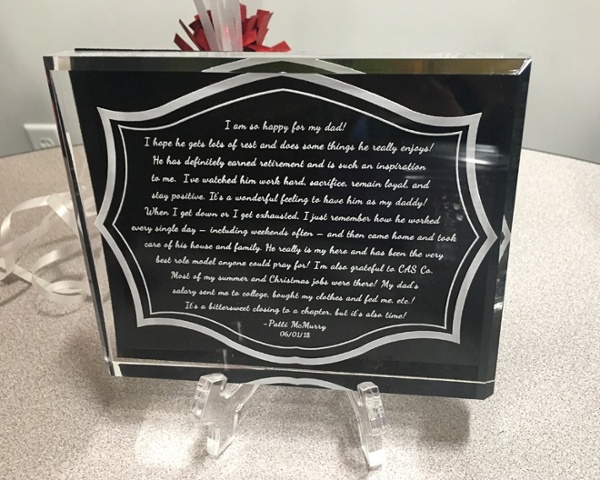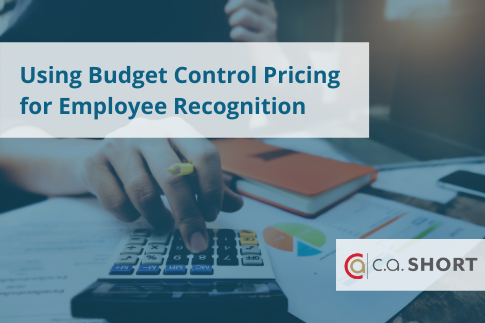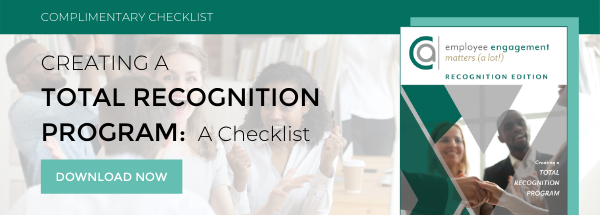
- Chapter 1: What Is Employee Recognition?
- Chapter 2: Why Does Employee Recognition Matter?
- Chapter 3: The Three Levels of a Total Recognition Program
- Chapter 4: 5 Ideas You Can Use to Improve Employee Recognition and Show Your Appreciation
- Chapter 5: Understanding Your Next Steps
Chapter 1: What Is Employee Recognition?
“Employee recognition” is a phrase that is used often, yet many times it is misunderstood by employees and management alike. The following definition adds clarity to what we mean when we use the phrase.
Employee Recognition: Acknowledging and rewarding the effort, accomplishments, and contributions of an employee or team when they reflect the values, mission, or goals of your organization.
While recognition can take many forms, the most effective recognition occurs when a company adopts a holistic approach. We refer to this comprehensive strategy as Total Recognition, and it requires companies to show their appreciation across three core levels: formal recognition, informal recognition, and day-to-day recognition.
We cover these areas in greater detail in Chapter 3. However, let’s first take a look at why employee recognition is so critical to the success of your business, as well as the many key performance indicators (KPIs) that improve when a company adopts a Culture of Total Recognition.
Chapter 2: Why Does Employee Recognition Matter?
It doesn’t matter if you’re selling hot dogs or hedge funds, employee recognition is critical to the success of your business. And, according to an abundance of troubling statistics, showing appreciation to your team has never been more important than it is right now.
Here are just a few of the reasons why.
Employee recognition improves retention, reduces turnover rates
The urgency to recognize your employees is tied, in part, to the terrible state of employee retention. Industries across America are struggling with record-high turnover rates, and some sectors are so crippled by low levels of retention that the entire industry’s survival is in jeopardy.
Do you know what influences an employee’s decision to leave their job more than any other?
That’s right, not feeling appreciated is the number one reason employees walk away from their employers. In fact, 66% of employees say they would leave their jobs if they didn’t feel appreciated. That number is even higher for millennials, with more than 75% reporting they’re happy to walk away from a job that doesn’t value them.
If history is any indication, this is a trend that’s likely to increase in the coming years. From 2012 to 2017, the number of respondents who indicated they would quit if they felt underappreciated rose by more than 50%.
Employee recognition is the cornerstone of employee engagement
In addition to improving retention and reducing turnover rates, employee recognition has a direct impact on a company’s employee engagement efforts. Recognition plays such a critical role in employee engagement that it’s included in one of the 12 questions Gallup asks as part of their Q12 research – the standard by which employee engagement is calculated both nationally and globally.
Gallup asks all participants to respond to the following statement: “In the last seven days, I have received recognition or praise for doing good work." How an employee responds here has a tremendous impact on their employer’s bottom line. Variation in responses to this question accounts for a 10%-20% difference in revenue and productivity.
Employees who are frequently recognized for their hard work significantly improve their company’s bottom line. And what about those employees who aren’t adequately appreciated?
For starters, they’re three times more likely to say they’re quitting in the next year. And if they do stick around, you can expect the quality of their work to decrease significantly. If this occurs, their disengagement can quickly spread to other employees and, soon, throughout your entire organization.
The benefits of increased employee engagement
Using employee recognition to boost engagement levels can result in significant benefits for your organization. While there are numerous examples we can point to, let’s look at 10 key metrics outlined in Gallup’s most recent State of the American Workplace report.
Reduced Absenteeism: Chronic, and even infrequent, absenteeism can cripple any business. However, when an employee is routinely recognized by their employer and engaged by managers and co-workers alike, absenteeism rates can reduce by as much as 41%.
Reduced Turnover: We mentioned it above, but it bears repeating: record-high turnover rates are destroying some of America’s greatest industries. But the good news is there’s help. When a company recognizes and engages their employees, they can reduce turnover rates by around 24% for high-turnover organizations. Low turnover organizations experience an even greater reduction – by nearly 60%.
Less Shrinkage: When an employee understands they’re valued and their work is appreciated, they want to protect their organization and its interests. This means they are far less likely to steal and will work to prevent others from stealing. As a result, organizations with the highest levels of engagement typically experience 28% less shrinkage than their peers with low levels of engagement.
Fewer Safety Incidents: Regardless of industry, an increase in recognition can lead to a significant decline in safety incidents. That’s because valued employees aren’t just concerned about their safety; they want to protect their co-workers too! As a result, highly-engaged companies see 70% fewer safety incidents.
Fewer Patient Safety Incidents: Recognition has also been shown to improve the safety of non-employees. This is especially true in healthcare, where highly-engaged teams experience 58% fewer patient safety incidents.
Fewer Defects: When employees are recognized and engaged, they produce products of a much higher quality. On average, engaged business units experience 40% fewer defects.
Higher Productivity: Productivity skyrockets when companies can effectively engage and recognize their team – by more than 17%.
Higher Sales: When your employees are recognized for their hard work, your customers will take notice (even if they don’t realize what it is they’re observing). This impact can lead to a 20% increase in sales. Cha-ching.
Higher Customer Metrics: An increase in spending isn’t the only way customers are affected by recognition and engagement. Metrics that illustrate an improved customer relationship experience also increase by more than 10%.
Profitability: Finally, it should come as no surprise that employee recognition, as part of an overall employee engagement strategy, can lead to increased profitability – by as much as 21%.
Chapter 3: Three Levels of Total Recognition
For your recognition efforts to deliver the kinds of results you’re seeking, they will need to be part of a broader, holistic strategy. This is called Total Recognition. This is a term you’ve likely seen, but you may not be familiar with what it entails.
Total Recognition consists of three equally essential levels your organization must utilize: formal recognition, informal recognition, and day-to-day recognition. Let’s take a closer look at each area, and the import roles they play in a Total Recognition strategy.
What Is Formal Recognition?
Formal recognition is what many businesses envision when they hear the phrase “employee recognition.” While this can take many forms, the most common is a Years of Service award program. However, formal recognition typically refers to any structured program with a defined set of criteria and processes that reward employees for accomplishing significant goals.
This form of recognition tends to occur as an annual or semi-annual event, where only a small percentage of standout employees are recognized – whether for hitting significant work anniversaries or meeting performance goals.
Although it is just a third of the puzzle, you cannot underestimate the value of a well-structured formal recognition program.
Years of Service awards are particularly effective when it comes to motivating and honoring your team, but much has changed since these ceremonies became a standard part of American culture. It has, after all, been more than 75 years since they were first widely adopted.
For example, Years of Service awards haven’t traditionally been awarded until an employee reaches their five-year anniversary. However, in today’s rapid pace world where turnover rates are at all-time highs, it no longer makes sense to wait this long to honor employees for their loyalty. Instead, consider offering awards beginning at the two- or three-year mark. Are you experiencing very high levels of turnover? Don’t be afraid to honor employees at more frequent intervals.
Best practices for offering years of service awards
The following best practices are designed to help you bring your Years of Service award into the modern era. You can read more about each tip – and discover TWICE as many best practices – in our article, 10 Best Practices for Creating Years of Service Award Programs That Work!
This blog also contains some great photos from a celebration we threw for Buford Ellis – a truly inspiring employee who retired after more than 60 years of service. We miss you, Buford!
-
Carefully plan your Years of Service award program (and stick with it
Your recognition efforts should never be an afterthought, and that is especially true for your formal recognition strategy. A Years of Service program can deliver tremendous ROI for your organization, though it will require you to spend some time and energy planning it. Once you’ve got a plan in place, the next important thing is to be consistent! Employees should receive rewards of equal value for reaching similar goals.
-
Personalize the awards ceremony
Regardless of the type of awards ceremony you’re hosting, it’s imperative that you personalize the ceremony for each employee receiving an award. To be effective, your Years of Service awards program will need to be memorable. So be sure to personalize the ceremony by mentioning specific examples of your employees’ contributions.
-
Get buy-in from your entire team
Notice we didn’t say you need to get buy-in from your executive team, management, or employees. You need buy-in from EVERYONE – whether they are a part-time intern or a long-serving CEO
-
Celebrate employees publicly
It’s absolutely critical that your organization praises employees publicly. This is true not only for formal recognition but also informal and day-to-day recognition. Publicly acknowledging your employees has many benefits, yet the two most important are likely that:
- It helps reinforce the positive action your employee took
- It inspires fellow employees to take similar actions
-
Involve your employees’ loved ones in the celebration
Another great way to make a lasting impact is to involve your employees’ loved ones in the celebration! So, be certain to extend an invitation to your employees family and friends. If they're unable to physically attend, there are other ways they can participate.
For example, Buford’s daughter couldn’t make it to his retirement ceremony. So, how did we handle it? We asked her to jot down some thoughts about the big day, and we etched them into a beautiful plaque. Here’s what it looked like:

If a fancy plaque isn’t in the budget, don’t count yourself out. Nearly everyone’s phone has a video camera, and many record in hi-def. Ask the loved one to record a few words and email it to your team.
What is informal recognition?
Informal recognition may not possess all of the glitz and glamor of a formal recognition program, but it’s equally effective when it comes to motivating and inspiring your team. In fact, it allows you to reach an even greater audience. At its core, informal recognition is meant to acknowledge progress towards specific goals or behavior changes.
This level of recognition is generally displayed towards individuals and groups. Informal celebrations may include low-cost mementos, a points-based safety incentive program, or even refreshments. The important thing is that you honor your employees’ achievements and outstanding behavior.
Regardless of how you show your appreciation, your informal recognition program should contain the five areas.
-
Personalization
As is the case with formal recognition, your informal recognition efforts should be personalized for the recipient. So, be sure your employee (and their co-workers) understand why he or she is being honored.
-
Meaningful
No one wants another silly trinket with the company’s name on it. For your informal recognition strategy to be effective, you need to offer your team rewards that are meaningful. It’s difficult to choose an impactful award for a single employee, but it can be close to impossible when you need to show recognition to a larger workforce.
This is one of the many reasons there’s been such a dramatic increase in companies that offer points-based incentive programs. We’ll cover this topic in greater detail a bit later, but here’s a brief overview of how they work: When employees are recognized for their efforts, they’re awarded points they can then redeem for the reward of their choice. It’s that simple! Just make sure you’re working with the right recognition company, as the rewards must be desirable to be effective, and the process is easy and simple to manage.
-
Immediate
For maximum impact, your informal recognition efforts should be as immediate as possible. This means that as soon as you can recognize and reward your employee for taking desirable actions, do so. Lack of immediacy is one of the reasons why year-end bonuses so often fail to deliver the results a company hopes for, and it’s another area where points-based incentive programs shine.
-
Simple
When it comes to structuring your informal recognition efforts, simplicity should be key. If the program is too complicated, managers won’t use it and employees will be frustrated by it – and your company will experience the EXACT OPPOSITE results it’s expecting. The process must be simple to understand and easy to use.
-
Public
Just because you aren’t having a fancy awards ceremony, it doesn’t stop you from publicly praising your employees. Reinforce the values of your organization by expressing gratitude to your employees in public – whether it’s in a group of their peers, an intranet site, or even via social media.
What is day-to-day recognition?
The final level of recognition, and perhaps the most important, lies in day-to-day employee recognition. This level should serve as the foundation of your total recognition strategy. What makes day-to-day recognition so critical? A few things.
Day-to-day recognition is frequent and ongoing. It’s also designed to reinforce the values of your organization even when they aren’t tied to a specific goal or project. When a co-worker or manager spots an employee going above and beyond, they can recognize the all-star in real-time.
There’s also a great deal of flexibility when it comes to day-to-day recognition. You can exhibit gratitude via instant award cards, verbal appreciation, and even eCards. Finally, this allows all employees to participate in engagement efforts by allowing them to both give and receive praise. This form of recognition – also referred to as peer-to-peer recognition – is so important it deserves its own section (see below).
Why is peer-to-peer recognition so important?
Peer-to-peer recognition is one of the most valuable tools in any business’ toolkit. Unfortunately, it’s also one of the most underutilized. This is a huge missed opportunity.
Consider the following benefits of peer-to-peer recognition:
- It encourages and motivates your entire team
- It’s inherently more scalable than recognition from management alone
- It’s an authentic expression of gratitude that can easily occur in real-time
- It can serve as a medium for regular feedback
- It helps reinforce a culture of achievement, collaboration, and support
- It reduces turnover costs by fostering meaningful relationships among your team
Tips for encouraging peer-to-peer recognition
If your company is looking for ways to encourage peer-to-peer recognition, you may want to read our blog, Fun and Easy Ways to Encourage Peer-to-Peer Recognition. We go into greater detail in that post, yet the following tips should still serve as a great starting place.
Use Employee Engagement and Recognition Software
One of the most effective means of encouraging peer-to-peer recognition lies in using employee engagement and recognition software. With the proper processes and technology in place, employees will be able to recognize their coworkers instantly and easily no matter where they’re located – making it a perfect fit for remote teams and businesses with employees located at multiple branches.
Just make certain you’re using a quality platform, as software solutions vary greatly.
Build a Wall of Thanks
Create a message board where employees can post thank-you notes to their peers, capture the accomplishments of others, or post photos of their co-workers’ successes. You can even create a digital “wall of thanks” so everyone can join in on the fun.
Encourage Post-It Praise
Speaking of fun, this next idea can be a blast for your entire team. Start by providing your employees with sticky notes, and then encourage them to leave their co-workers praise. They can do this at random times throughout the day, or wait until their co-worker is on a break to surprise them.
Chapter 4: 5 Ideas You Can Use to Improve Employee Recognition and Show Your Appreciation
The following methods are designed to maximize the impact of your employee recognition efforts while making it easier for your company to show appreciation to team members at every level of your organization.
1. Speak the “Language of Appreciation”
It can be difficult to express gratitude to your employees when you’re speaking different languages. Dr. Paul White sat down with C.A. Short Company to clear up this confusion in his groundbreaking presentation, Improving Staff Morale Using the 5 Languages of Appreciation. Discover how you can avoid “going through the motions” and show authentic appreciation to your employees by watching the on-demand webcast.
2. Create a culture your employees will love
Your corporate culture is incredibly important to the success of not only your recognition efforts but also to your engagement and safety initiatives. That’s because when employees feel like they’re part of a true community – and their company exhibits the same values and mission – they work harder, smarter, happier, and safer!
Creating a meaningful culture isn’t something you can do overnight, but it is something you can start today! A great first step would be to watch this amazing on-demand webcast with Katie Burke. Katie serves as the VP of Culture and Experience at HubSpot – a corporate juggernaut that consistently ranks as one of the best workplaces in America.
3. Think big picture
It’s imperative that you think big picture here. Offering only Years of Service awards or sending “thank you” cards once a year isn’t a sufficient way to show your employees how much you appreciate them. That’s why you must create and maintain a Culture of Total Recognition.
For ways you can accomplish this, you can download our complimentary checklist, Creating a Total Recognition Checklist.
To have an even greater impact, your Total Recognition strategy should be part of an even BIGGER picture. At C.A. Short Company, we refer to this approach as Total Recognition. By simultaneously focusing on engagement, recognition, and appreciation, your aligned efforts deliver much higher results than if you were to focus on only one (or even two) of these areas.
4. Offer employees a values-based recognition program
The single most effective action your company can take is to offer employees a values-based recognition program that allows you to instantly reward positive employee behavior. This is typically accomplished through a points-based reward system. However, some organizations prefer to use a more traditional, stamp-based incentive program.
When employees participate in programs like these, they understand their work has meaning and purpose. As a result, their work performance is much more likely to improve. Employers also report positive outcomes –stating that honoring employees for their contributions delivers one of the greatest returns on investment.
5. Work with a professional recognition and reward company
Finally, to maximize your recognition efforts and minimize your headaches, it’s a good idea to work with a proven recognition leader. Just be certain you choose a quality recognition and reward provider, as not every solution is created equal. Before partnering with any third party, do your homework:
- Research the company and their track record. Do they have a rich history in the world of employee engagement and recognition, or are they a new and unproven entity? What companies have used them and what results have they achieved?
- Request a demo. The proof is in the pudding. Any company worth its salt will offer a free demo of their tools and/or consultation.
- Inquire about support. Many companies are quick to help you during the sales process, though not many stick around after you shell out the big bucks. You should work with a provider that offers superior (and ongoing) support – from sales to implementation and beyond.
Chapter 5: Understanding Your Next Steps
By now you should have a clear understanding of what employee recognition is and how you can start showing your team the appreciation they deserve.
However, like anything worth doing, improving your company’s recognition efforts will take a lot of time, energy, and resources. The good news is you don’t have to go it alone. The even better news is that C.A. Short Company is here for you!
We’ve been in the employee engagement, recognition, and safety industry for more than 80 years, and we’d love the opportunity to help your company honor, protect, and reward your company’s greatest asset – your people. We love when businesses care as much about their employees as we do ours.
If you’d like to learn more, you can give us a call anytime at 1-800-535-5690. You can also request a complimentary consultation without ever having to leave your desk.
Editor's Note: This post was originally published in 2018 and has been recently updated.




.jpeg)

.jpg)



SHARE